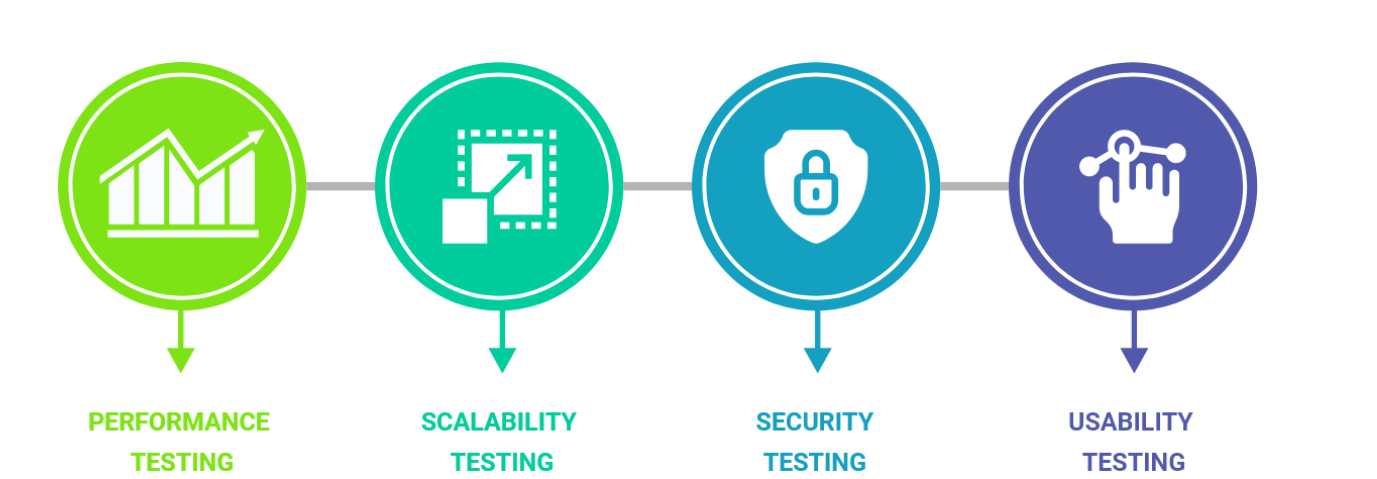
Introduction: What is Non-Functional Testing?
Non-functional testing is a type of software testing that is not related to the functionality of the software. It focuses on the performance, scalability, reliability, usability, and security of the software.
Performance Testing: Performance testing tools help to measure the performance of an application. It is done by checking if the system meets the desired performance criteria. If it does not meet the desired performance criteria, then it helps to analyze the reason for the sluggishness.
Scalability Testing: Scalability testing for an application is done when there is a prediction or planning for future upscaling or downscaling of the software or application. When the software/application is passed through this type of testing, it is generally to observe the options for increasing or decreasing certain system features and functionalities, like the volume of data, performance of the system, number of processes complete at a given time, or number of users using the system at a given interval of time, etc.
Security Testing: Security testing tools help to check whether a system has been compromised or not. They also help in finding out how secure a system is, what vulnerabilities exist and what can be done to improve security.
Usability Testing: Usability testing tools help in measuring how easy it is for an end-user to use a product without any assistance from other people. It also helps in finding out usability issues and improving usability of a product so that more people can use it with ease.
Below are some of the tools widely used in the market for performing non-functional testing. The table clearly explains the type of tool and which tool is more popular in the market based on the load/usability/scalability/security testing requirement. It also describes whether the tool is open source or paid, as well as any pros and cons of each tool for reference.
| Testing Tool | Type of Testing Tool | Mobile/Web Application | Open Source | Pros | Cons |
| Jmeter | Load Test | Both | Yes | 1) User friendly 2) Used for HTTP, HTTPS, FTP applications. 3) Quality compatibility testing. | 1) Consumes lots of time and resources. |
| Load Runner | Load Test | Both | No | 1) Accurate results in performance testing. 2) Stress results in information. 3) Multiple users. | 1) No User-friendly interface. 2) Snapshot for record and replay should be scrolled in parallel. 3)Doesn’t support JavaScript, so it doesn’t support AJAX requests by extension. |
| BlazeMeter | Load Test | Both | No | 1) Its compatibility with open source with “Apache Jmeter”. 2) No expertise is needed to do the load testing. | 1) Not available for free. 2) Blazemeter is costly. Testing with volumes of more than 1K cu is expensive |
| Crazy Egg | Usability Test | Web | No | 1) Easy and fast installation. 2) Great UX and UI within the tool. 3) Good visual reporting. | 1) Heat mapping with limited visualizations 2) Pricey for users who have a lot of page views 3) Annual billing |
| TryMyUI | Usability Test | Both | Yes | 1) Audience targeting. 2) Conducting surveys. 3) Mobile Testing, Video screen caps, Mouse clicks and screen strokes. | 1) Setting up a test a bit complex 2) No option to save your test scenario. 3) No option for automated user testing |
| Gatling | Scalability Test | Web | Yes | 1) Open-source, code reusability and versioning. 2) Multithreading, assertions, reporting, CI/CD integration. | 1) Protocol support, lots of scripting. 2) Lack of support material, test execution data. |
| Load Ninja | Scalability Test | Web | No | 1) Hosted in the cloud. 2) Real browser load test execution at scale. 3) VU Debugger debugs tests, VU Inspector manages virtual users. | 1) Completely relies on AJAX, which relies on JavaScript; so it doesn’t work if JavaScript is disabled or not supported. 2) Dynamically displayed and loaded data is not a part of the application page. 3)Expensive. |
| Burp Suite | Security Test | Both | No | 1) Manual penetration testing and configuration tweaks. 2) Automated bulk Scanning and simulated scenarios 3) Report generation. | 1) Setup for proxies is cumbersome and takes some time to get set up. 2) Doesn’t describe how to test different vulnerabilities. |
| Sonarqube | Security Test | Both | Yes | 1) Supports C#, Java, PHP, flex, Ruby. 2) Static Code Analysis. 3) Configurable quality gates for PR analysis. | 1) Better IDE integration and Support. 2) Easier GitHub actions integration and support. 3) Expensive. |
The Benefits of Using Non-Functional Test Tools
There are many benefits to using non-functional test tools. One advantage is that they can help with automation and speed up the process of NFT, thus saving time and money. They also have less chance of being fooled by a bug, so they can find the bug before it becomes a problem for customers. Furthermore, they can be used to test for any kind of product or service as most of the tools are very versatile.
Conclusion: The Importance of Using Non-Functional Testing Tools that Will Help Improve Quality of Your Products
Non-functional tests are often overlooked by all the stakeholders, which can lead to serious consequences for their products. These tests are often skipped because they are not as popular as functional or unit tests and they require a lot more time, skilled resources, and money.
Non-functional testing tools are used to improve performance and quality of a product beyond its functionalities. Based on the project/product and type of the application, one should select suitable tools for their project depending on their budget and required features. These days, “Open” source options are also available which helps to reduce the licensing cost and makes Non-functional testing also affordable.
Visit our TCOE for more information or let us know if you have any other questions!

